Birds That Love Winter
Montana may not strike you as the perfect place to spend the winter, but every year thousands of travelers disagree. Most of the feathered ones from the north flit past, true, but others recognize the Treasure State as the ultimate place to chill out for months. They migrate here every year: rough-legged hawk, snowy owl, northern shrike, common and hoary redpoll, American tree sparrow, Bohemian waxwing, snow bunting and Lapland longspur.
Have these birds taken leave of their senses?
Well, no. But in every case, they’ve taken leave of their Arctic breeding grounds to get here.
Take the rough-legged hawk. Its feathers cover its legs to the toes, and a small bill and feet keep the heat loss down. But as the days shorten, these hardiest hawks flee south, stopping only when they get to a narrow strip of southern Alberta, the state of Montana, or the lands beyond.

Montana’s average winter temperatures run about 40 degrees warmer than the tundra and uplands that the “roughies” left behind. More importantly, the supply of voles, even when shared with red-tailed hawks, will get the rough-legs through winter. While red-tails opt to hunt from a tree, rough-legs prevail in open country, so similar to the tundra. They don’t disdain a perch for hunting—a power pole is a popular choice—but they can hover and kite with ease over a perchless grassland. When the rodent supply falters or gets buried in snow, carrion and roadkill fill the gaps, along with prey stolen from other raptors. All together, they carry the roughies to spring.
How different from the snowy owl. A substantial bird, this open-country predator also feeds primarily on voles in winter, at least in Montana. But instead of joining the rough-legs south of Alberta, the snowies fill the space to the north, all the way to the tundra. A wedge running along the northern edge of Montana adds to the snowy’s normal winter range. When a booming population brings an irruption year, the owls spill across our entire state and well into the lower 48.
The snowy owl comes well-equipped to winter north of the rough-legged hawk. Larger and more compact than the hawk, the owl can also hunt by day or by night, helpful in the long Arctic darkness. Its feathers protect more of it (bill and mouth obscured, feet covered), and with enough density to rival the insulation of an Arctic fox. It also has an insurance policy. This owl can go 22 to 40 days without food, possibly related to its thick layer of fat.

One more predator comes from the north, the northern shrike. This songbird also wears a hooked bill and zeroes in on voles.
If snow deepens enough to hide the voles, northern shrikes will switch to hunting for small songbirds. They have another fallback, too. When prey is plentiful, they hang their kill over a branch, building a larder for times of scarcity. Surprisingly, its song, which mimics others and increases in late spring, attracts songbirds. It may be a handy lure just as the rodent supply weakens.
Undue depth of snow does not cover only prey. It also covers the seed-eater’s food. American tree sparrows, which forage on the ground, have a solution for that. They beat at grasses with seedheads above the snow, dropping seeds to the white surface. When snowfall rises above seedhead level, the sparrows turn to bird feeders or wander to less snowy areas. Open country where grass and weeds poke out of the snow works best for this sparrow, which winters farther north than any other, including much of Alberta. On occasion it takes refuge under the snow, roosting together with others of its kind.
At the low end of the temperature spectrum, research shows this hardy sparrow can handle subzero temperatures, provided it consumes enough calories. Its usual daily diet of seeds amounts to 30 percent of its weight.

The entire population of American tree sparrows evacuates its breeding grounds for the winter, but the even hardier common redpoll leaves some of its kind to winter on the breeding grounds. Like the snowy owl, the wintering redpolls fan out all the way from the Arctic to just over the Montana border in normal years. In irruption years, roughly every other year, they cover the state.
The common redpoll, so much smaller than a snowy owl, has a tall order when it comes to keeping warm. Like the owl, this finch has extra feathering (31 percent more feathers by weight in November compared to July) and extra fat (50 percent more than they do in summer). It can also feed at night. In addition, this small bird that winters in the Arctic interior has a sizeable throat pouch to store the birch seed it eats—
a handy pocket for a midnight snack, and a way to carry seed to its snow tunnel for husking, sparing it from more time in the elements. The redpoll also roosts and sleeps in the tunnel.
As for the hoary redpoll, this scarce species differs only subtly from the common redpoll in just about all respects. Even in an irruption year, only a few are reported in Montana, where together with common redpolls, they linger around brush, weedy fields, and backyard feeders.
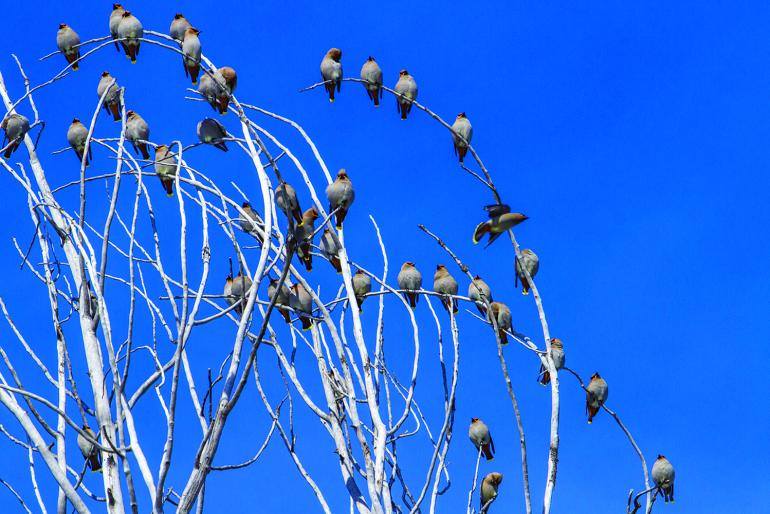
Snow buntings and Lapland longspurs tend to flock together in winter, too, when they join with resident horned larks. Open, windswept fields such as shortgrass prairie, overgrazed pastures, and stubble fields are their paradise, where the wind moves light snow cover off their seeds. When heavier snowfall arrives, the flocks wheel off to a less snowy area, or at least the edge of a gravel road that’s been scraped by a snowplow.
Snow can aid the snow bunting, as well. It provides camouflage and helps the bird change into its breeding plumage in late winter. That’s when the bunting rubs against hardened snow to take the tips off its feathers, revealing its underlying breeding plumage. When snow buntings arrive on the tundra in early spring, temperatures may still be 22 below, but the early bird gets the safest rock crevice for nesting, a great incentive. This tolerance of cold, aided by feathering on its ankles, also shows in the location of its wintering range, which reaches north to the boundary of Alberta and the Yukon Territory.

Lapland longspurs, on the other hand, barely get as far north as Alberta in an ordinary winter.
The remaining bird in the migrant crew, the Bohemian waxwing, stands apart. It can laugh at snow depth, because in winter it eats nothing but the fruit that persists in trees and shrubs. It eats twice its weight in fruit each day. That’s a lot of well-scattered food to find, but the flock roams together and then strips a tree in a matter of hours. A benefit to Bohemian waxwings in cold weather is the repeated freeze-thaw cycle that softens fruit, allowing the birds to swallow it whole.
Montanans can rejoice that what’s born in the North doesn’t stay in the North. From the common redpoll to the snowy owl, our incoming migrants add much interest to the winter season.



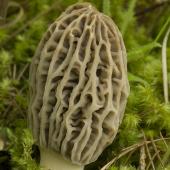
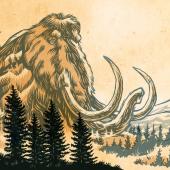
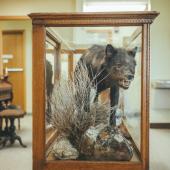
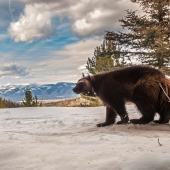
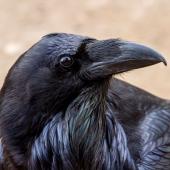

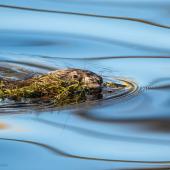
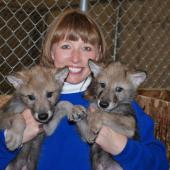

Leave a Comment Here